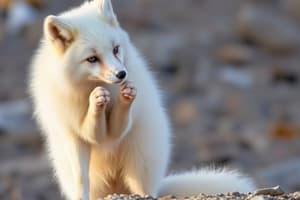Podcast
Questions and Answers
What is the purpose of the thick fur of Arctic foxes?
What is the purpose of the thick fur of Arctic foxes?
- To protect their eyes from glare
- To blend in with their surroundings
- To conserve energy and keep warm in extreme cold (correct)
- To move easily on snow and ice
What is the main purpose of the white fur of Arctic foxes?
What is the main purpose of the white fur of Arctic foxes?
- To blend in with their snowy surroundings (correct)
- To move easily on snow and ice
- To protect their eyes from glare
- To keep warm in extreme cold
What is the primary function of the small ears and body of Arctic foxes?
What is the primary function of the small ears and body of Arctic foxes?
- To conserve energy and reduce heat loss (correct)
- To blend in with their surroundings
- To move easily on snow and ice
- To protect their eyes from glare
What is the typical habitat of Arctic foxes?
What is the typical habitat of Arctic foxes?
What is unique about the paws of Arctic foxes?
What is unique about the paws of Arctic foxes?
Study Notes
Adaptations
- Thick fur: Arctic foxes have two layers of fur: a thick undercoat and a longer, guard hair layer. This combination provides excellent insulation, keeping them warm in extreme cold.
- White camouflage: Their white fur helps them blend in with their snowy surroundings, making it easier to hunt and avoid predators.
- Small ears and body: Their compact body shape and small ears reduce heat loss, conserving energy in the harsh Arctic environment.
- Specialized paws: Their furry, flat paws act as snowshoes, allowing them to move easily on snow and ice.
- Cold-resistant eyes: Their eyes are adapted to protect them from the intense glare of sunlight on snow and ice.
Habitat
- Arctic tundra: Arctic foxes inhabit the Arctic tundra, a treeless region found in the northernmost parts of Canada, Alaska, Greenland, Norway, and Russia.
- Sea ice and coastlines: They can be found on sea ice and along coastlines, where they hunt for seals, their primary food source.
- Denning behavior: Arctic foxes dig complex dens, often using existing burrows or rocky outcrops, to shelter from harsh weather and raise their young.
Studying That Suits You
Use AI to generate personalized quizzes and flashcards to suit your learning preferences.
Description
Learn about the unique adaptations of Arctic foxes, such as their thick fur and white camouflage, that help them thrive in the harsh Arctic environment. Discover their habitat, including the Arctic tundra and sea ice, and how they survive in these areas.




